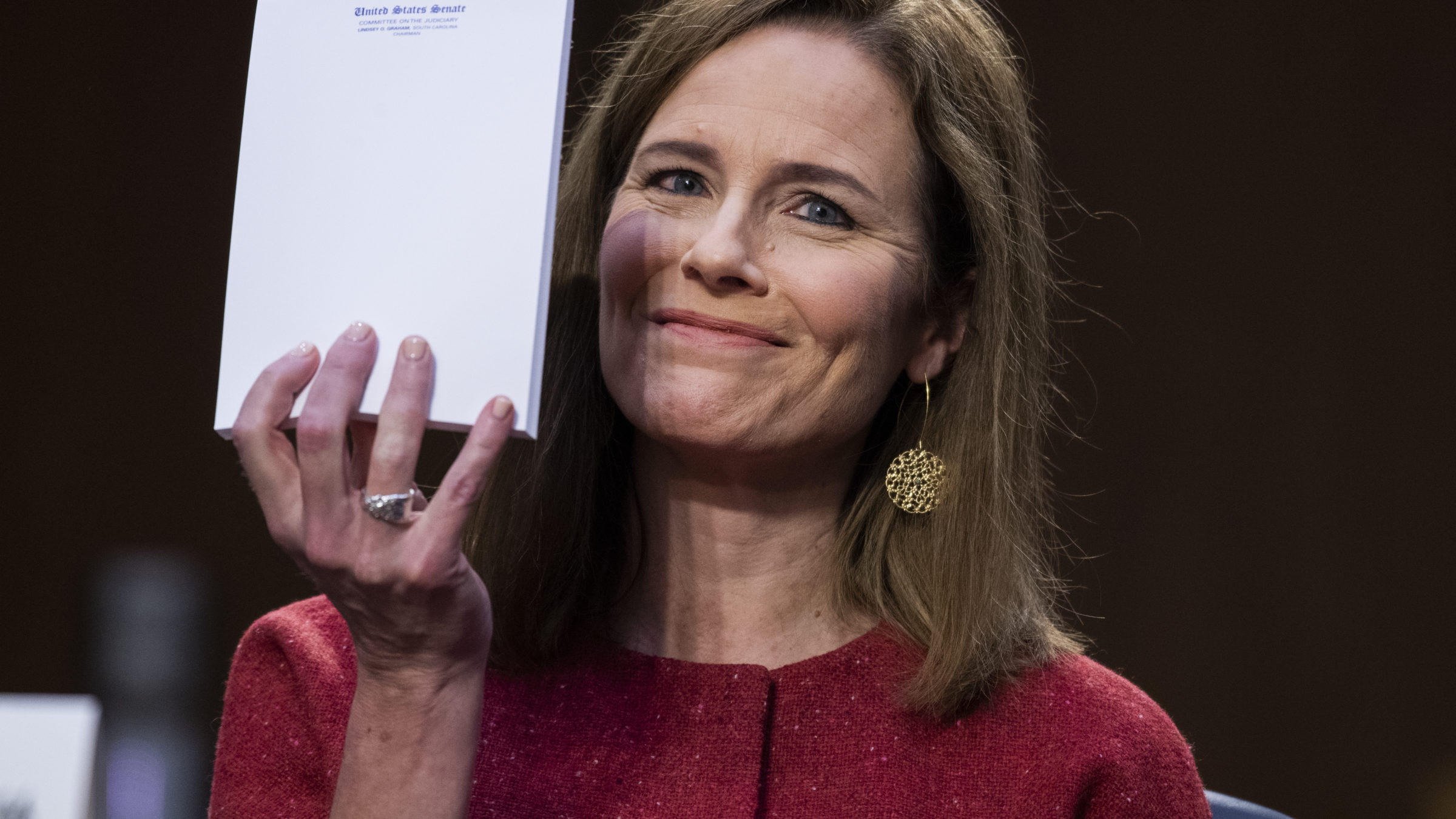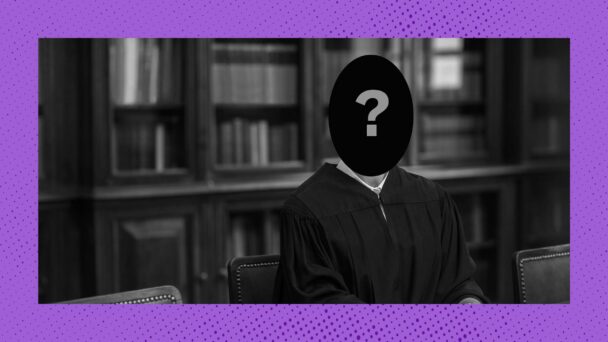In the months following Justice Amy Coney Barrett’s confirmation in October 2020, a popular theory in certain circles of legal punditry was that the new Supreme Court was best understood not as controlled by six conservatives, but instead as a “3-3-3” Court. In one corner were Clarence Thomas, Samuel Alito, and Neil Gorsuch—three Republican-appointed reactionaries eager to reshape American society in the graven image of Roger Ailes. In the other were Sonia Sotomayor, Elena Kagan, and Stephen Breyer (and, later, Ketanji Brown Jackson)—three Democratic-appointed liberals who would, if the first trio got its wish, be confined to writing mournful dissents for the foreseeable future.
The fate of the Court, 3-3-3 proponents argued, thus hinged on the three Republican appointees who fell somewhere to the right of center: Barrett, Brett Kavanaugh, and Chief Justice John Roberts. Because these three prioritize the Court’s institutional legitimacy, the hypothesis went, they would act as a check the more grandiose ambitions of their less prudent conservative colleagues, their shared policy preferences notwithstanding. In early 2021, versions of this narrative that lauded the Court’s supposed restraint were published not only by conservative law professors, but also by CNN, Politico, and The Economist. “So much for a rock-solid 6-3 conservative Supreme Court majority,” wrote Bloomberg’s Kimberly Strawbridge Robinson, a common sentiment at the time.
These predictions proved staggeringly wrong. Over the past three years, an incomplete list of the Court’s achievements includes striking down the Biden administration’s student loan forgiveness program, creating a right to possess guns in public, barring a workplace safety rule that would have protected millions of workers from a deadly pandemic, strengthening the rights of religious Americans to discriminate against LGBTQ people, abolishing affirmative action, and hacking away at what remains of the Voting Rights Act. The conservative supermajority has been so dominant that they could afford to lose a vote and still overturn Roe v. Wade, thus ending the right to abortion care after five decades of trying.
Undaunted by the lopsided score, Sarah Isgur, a conservative legal pundit and former Trump Justice Department spokesperson, and Dean Jens, an economics professor at the University of Central Florida, have refreshed the 3-3-3 Court narrative for 2024. Isgur is not new to this beat, but this time, she unleashes the most formidable weapon in the blogger’s arsenal: color-coded spreadsheets. “Our new mathematical analysis of the court’s decisions from the 2022-2023 session shows just how much it makes sense to think of this Supreme Court as a 3-3-3 court—one whose divides are driven not just by ideology, but a range of other legal considerations as well,” Isgur and Jens write in Politico.
On its face, this take seems reasonable enough. Of course some of the Supreme Court’s many decisions are informed by considerations other than 100 percent ideology; if they weren’t, every decision would be 6-3 and every Supreme Court pundit would be out of a job. But magnifying the significance of occasional, marginal differences between conservative justices is myopic at best and misleading at worst. By downplaying the real-world accomplishments of the six-justice conservative supermajority, the 3-3-3 Court framework delivers the impression that the six-justice conservative supermajority does not really exist.
This, as anyone who has lost one or more legal rights over the past few years can attest, is incorrect. The numbers and charts here might feel authoritative, especially to lawyers who are terrible at math. But they yield no new insights about the impact of the justices’ rulings, and thus mostly serve to obfuscate the fact that the Supreme Court is the Republican Party’s most important source of political power, and may very well remain so for another generation. When the Court’s swing justice is, on a good day, Brett Kavanaugh, liberals aren’t “winning” in any meaningful sense of the word. They are just losing a little more slowly.

Barrett lists recent liberal wins at the Supreme Court (Photo by Tom Williams-Pool/Getty Images)
Isgur is a lawyer and Republican operative who has worked on the campaigns of Ted Cruz, Mitt Romney, and Carly Fiorina. She rose to national prominence as a spokesperson for Attorney General Jeff Sessions, which made her, for a time, the public face of the Trump administration’s family separation policy and its various attempts to institute a Muslim ban. Since leaving politics (?) and completing the mandatory bit of solemn reflection about her work on behalf of an aspiring authoritarian, Isgur has become a fixture of the conservative-but-not-Trump-conservative media ecosystem. Today, she hosts a popular legal podcast and serves as an analyst for ABC News, because there is nothing legacy media outlets love more than offering a redemption arc to someone who is in dire need of one.
Isgur and Jens begin as all purveyors of the 3-3-3 Court narrative must: by listing some numbers that “might surprise you.” Last term, for example, the Court resolved about half of its cases unanimously. Only five of 57 cases—“just 8 percent”—featured the six conservatives in the majority and the three liberals in dissent. Ninety percent of majorities featured at least one liberal justice, and the six conservatives voted together only 17 percent of the time. The implication here is that for a Court that is supposedly in the iron grasp of right-wing culture warriors ready to rubber-stamp every Jonathan Mitchell fever dream, the results have been a little less one-sided.
To (ostensibly) make sense of these (purportedly) counterintuitive numbers, Isgur and Jens use an algorithm that looks at how often each justice votes with each other justice, and then plots those relationships on a pair of axes. Sure enough, there are the three distinct clusters of three disembodied heads, exactly as the prophet David Lat foretold.
There was a wave of “It’s actually a 3-3-3 Court!” takes in 2021, when the rightwing supermajority decided it was best to wait another term before going full berserk on democracy and the modern state. That was just regular dumb.
Resurrecting them now is next-level bizarre. pic.twitter.com/fx382JvRlI
— Thomas Zimmer (@tzimmer_history) June 3, 2024
As Isgur and Jens explain, the algorithm doesn’t explain what the relationships between the justices are or why they exist. But in a stroke of good luck, the visual it produces aligns neatly with the modern right-left spectrum: They label the x-axis as ideology, the y-axis as institutionalism, and bleep-bloop-blorp, there is the 3-3-3 Court in all its Microsoft Excel Chart Wizard glory. “These charts don’t aim to show that ideology doesn’t play a role in today’s Supreme Court,” they write. “But they also show that ideology alone can’t explain most of the outcomes at the Supreme Court.”
This is an ambitious exercise in goalpost-moving, lightly repackaged as quantitative analysis. When normal people describe the Supreme Court as “ideological,” the point is not that “ideology alone” explains “most of the outcomes.” The point is that right now, whenever the conservative justices feel like making some law, they have the numbers (and then some) to do it. Ruminating about the precise blend of ideological zeal and institutional fealty and whatever other abstract factors might determine an individual justice’s vote is irrelevant to the real-world consequences of the Supreme Court’s work. Right now, when the law moves, it moves in one direction. The only question is how far the Court feels like moving it.
The most obvious mistake that 3-3-3 Court thinkpieces typically make is flattening the stakes of cases, many of which do not have partisan implications worth noting. Instead of focusing on the blockbusters, proponents point to, say, the frequency of unanimity or the emergence of across-the-aisle coalitions as evidence that the justices are not, to borrow Barrett’s phrasing, a bunch of partisan hacks. But a 9-0 opinion about, say, the government’s waiver of sovereign immunity under the Fair Credit Reporting Act is not evidence that the Court is a neutral, apolitical interpreter of the law. It is a byproduct of the fact that sometimes, the Court has to address legal questions that are profoundly boring.
To get around this problem, Isgur and Jens argue that the definition of “important” or “divisive” cases is inherently subjective. To make the point, they contrast two cases from last term: In Biden v. Nebraska, by a 6-3 vote along ideological lines, the Court struck down the Biden administration’s student loan forgiveness plan. And in United States v. Texas, by an 8-1 vote, the Court (over Alito’s objections) turned away a crackpot legal theory that would have empowered state officials in Texas and Louisiana to tell the federal government how to do immigration policy. These results, Isgur and Jens argue, demonstrate the circular nature of labeling cases as “politically divisive”: One earned splashy headlines because it featured six Republican appointees challenging and defeating the Biden administration, and the other did not because it did not.
Isgur and Jens also highlight three cases in which the justices addressed hard questions about “how to deal with the country’s history of racial discrimination”: Allen v. Milligan, in which Roberts and Kavanaugh joined the liberals to save Section 2 of the Voting Rights Act; Haaland v. Brackeen, in which Roberts, Gorsuch, Kavanaugh, and Barrett joined the liberals to uphold the Indian Child Welfare Act; and Students For Fair Admissions, in which the six conservatives outlawed affirmative action over a dissent from the three liberals. Again, Isgur and Jens argue that all three cases are important, but that because the first two “didn’t line up strictly on ideological lines,” the media dismissed them as “not divisive.”
There are three basic problems with this analysis. First, by quibbling about the meaning of “important” or “politically divisive” cases, Isgur and Jens skip past the simplest available definition: how much the two major political parties care about the result. Again, when normal people talk about their objections to a “politicized” Court, they are not literally asserting that the six conservatives vote in lockstep every single time. They are referring to the sense, borne out by three years of watching the Court stuff precedent after precedent in the garbage, that the more important a case is to the Republican Party’s policy agenda, the likelier the Republican Party is to be pleased when the opinion finally drops.
This framework pretty easily resolves the ambiguity to which Isgur and Jens point: The Court decided Students For Fair Admissions as it did because Republicans oppose affirmative action and have long vowed to end it. The Court decided Biden v. Nebraska as it did because it was a chance to harm a high-profile initiative of a Democratic president whom Republican politicians had criticized relentlessly. Milligan, in which a bare majority of the Court declined to kill off Section 2 of the Voting Rights Act, might be more persuasive support for Isgur and Jens’s thesis if the Court hadn’t gutted Section 2 two years earlier, with—you guessed it!—all six conservatives in the majority. By confining their analysis to the previous term, Isgur and Jens avoid having to say anything about Dobbs v. Jackson Women’s Health Organization, the clearest example of the Court fulfilling an oft-repeated GOP promise.
Isgur and Jens also ignore what it actually means to “win” a case, erasing the distinction between conservative victories that make sweeping changes to the law and liberal victories that, at most, preserve a fragile status quo. Again, consider their examples: The student loan forgiveness and affirmative action cases torpedoed a Democratic president’s signature agenda item, and shredded a longstanding legal principle that addresses discrimination against people of color. Milligan and Brackeen merely allowed the Voting Rights Act and the ICWA to survive; Texas denied Republican politicians the power to commandeer U.S. foreign policy (for now). Sure, the conservative justices splintered in these cases, but the results are only “victories” for the left in the sense that they were not total blowouts.
Lastly, Isgur and Jens gloss over the importance of the questions that a Court with near-total control over its docket is choosing to spend its time. The conservative advocates who litigate these cases and the lower court judges who hear them understand that this Court is the friendliest audience they’ve had in a century, and none of them—especially on the FIfth Circuit—are holding anything back right now. Brackeen presented the justices with the opportunity to destroy the concept of Tribal sovereignty. The Milligan dissenters were a few votes away from empowering Republican-controlled legislatures to discriminate against Black constituents even more freely than they do already. A different result in Texas would have handed the keys to America’s deportation machine to, of all people, Greg Abbott.
What’s remarkable about these arguments is not that they failed to earn five votes. It’s that right now, lawyers are comfortable walking into the Supreme Court, standing before the lectern, and saying this shit with a straight face, because they know that no matter how deranged they might have sounded 20 or 10 or even 5 years ago, before this particular lineup, their long-shot bets just might hit. In that sense, Isgur and Jens have a point: Even when the Alliance Defending Freedom litigation squad comes up short, it can at least count on a righteous dissent from one or more of Thomas, Alito, and Gorsuch—a dissent that, with any luck, might become a majority opinion the next time they decide to take a shot.
A Supreme Court that carefully considers and eventually rejects whatever reactionary slurry James Ho cooks up is not a sign of a Court guided by the firm, steady hand of an institutionalist trio. It’s a sign of a very conservative Court that James Ho does not sit on (yet).
Isgur and Jens frame their analysis as a wonky look at voting relationships between individual Supreme Court justices—the sort of arcana that will forevermore be interesting to law professors who have exams to grade and appellate litigators who have hours to bill. But Isgur knows what she is doing here: The throughline of the last three years is that the Supreme Court does what is best for the Republican Party when the stakes for the Republican Party are highest. The purpose of the “3-3-3 Court” framework is to muddy the waters just enough so that maybe you’ll forget about it.







